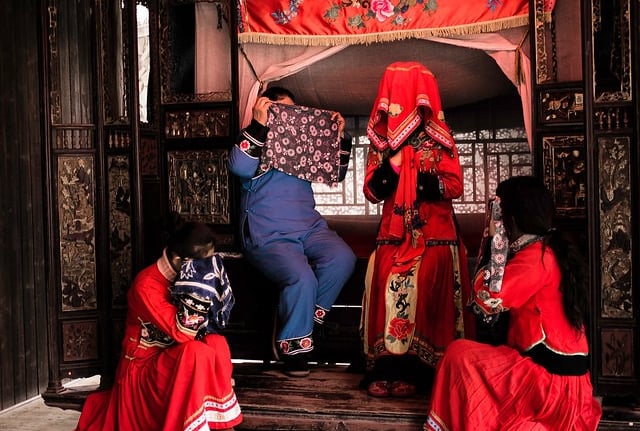哭嫁; Crying Marriage
Usually, people get married with all smiles to celebrate what may just be the most joyous day of their life, and a union between a couple dizzyingly in love. This, however, is not the case for the young women of the Tujia community, who cry on their wedding day!
7/10/20242 min read


Photo credit: 土家族文化网
When a Tujia girl gets married, it is essential that she knows how to cry, a custom referred to as "crying marriage” or “哭嫁” (kujia) This crying is not just any crying; it should be melodious, moving, and such a skill is considered an art, complete with a special “Crying Marriage Song.” Tujia girls start learning this crying from the age of twelve or thirteen. In the past, a girl who did not cry was not allowed to marry. Nowadays, the practice of crying marriage still exists only in remote mountainous hamlets.
A bride usually starts her crying one month before the wedding, though some begin just two or three days or even one day ahead of the wedding. While her family prepares her dowry, they also share stories of separation and sadness. The girl must cry without repeating herself over the month, crying for her ancestors, her parents, her brother and sister-in-law, her sisters, the matchmaker, and herself. The form is to cry through singing, with tears accompanying the song. The lyrics follow traditional patterns, but clever girls also create impromptu verses inspired by their surroundings. Tujia girls use crying as a way to express deep emotions, although some truly cry out of sorrow, often due to meddling matchmakers who mismatch partners, ruining the girls' lives.
The climax of the crying marriage occurs on the bride's wedding day. On the day before the wedding, relatives and neighbors come to congratulate and cry farewell. The bride's family invites nine of her best unmarried female friends to join in the crying, called the “Ten Sisters’ Gathering.” These nine girls play a significant role, and regardless of whether they live near or far or what the weather is like, the bride's family sends people to fetch them. Once the ten sisters gather, two tables are joined together in the center of the main room; older girls sit at the head and girls of similar age to the bride sit on either side, with the bride in the middle. The main focus of the crying is to talk about sisterhood, but words of encouragement and consolation are also offered.
The crying continues until midnight when the bride's family serves a midnight snack for the ten sisters, and the bride cries again to express her gratitude for their company. In an era dominated by arranged marriages, where matchmakers usually dictate matrimonial alliances, brides often use their crying to scold matchmakers and express dissatisfaction with old-fashioned marital practices.
Crying marriage is the prelude to Tujia weddings, encapsulating the belief that “no crying means no festivity, no beauty in the ceremony." Friends and family come to send off their loved one, and crying is seen as a friendly gesture, a polite tribute. To those present who choose not to participate in the crying and instead just sing, the bride feels disrespected and displeased.
